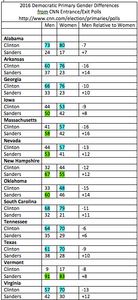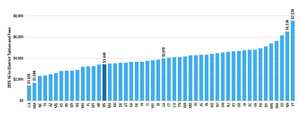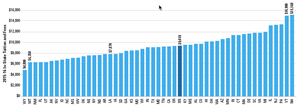Here's my initial, quick take on Super Tuesday, introduced and in dialogue with Margaret Waterman in the BU Professor Voices series:
Super Tuesday has come and gone, and Massachusetts voters (as well as voters from 11 other states and American Samoa) have spoken their minds. Donald Trump and Hillary Clinton came out largely victorious, but Ted Cruz and Bernie Sanders notched some victories as well. What does this mean for Massachusetts, and for the election going forward?
Virginia Sapiro is a Boston University professor of political science and an expert on public opinion, political behavior and electoral politics. She is also a former director of the American National Election Studies, the major scholarly survey of American voters that has been in operation since 1948. She broke down the results of Super Tuesday for us in the following Q&A:
Q: Let’s talk about local issues for a moment: Massachusetts had its primary today, and Donald Trump and Hillary Clinton won. Vermont did too, where Trump and Bernie Sanders won. Was this a surprise or an expected result, given local pre-primary polling data?
VS: Let’s start with the Democrats, who will no doubt take both states in the general election. Senator Sanders’ home state went fully as expected — he is a very popular figure there. We have known for some time Massachusetts would be a highly contested state, and it clearly was at the photo-finish line. Clinton’s close win gives her 2 more delegates than Sanders gets from Massachusetts. The town-by-town results are very interesting (people can see for themselves in The Boston Globe). Clinton took most of the Boston area, Worcester area, the Fall River-New Bedford-Falmouth area, and the Lowell-Lawrence area. Sanders took many more towns, but his strength was in the smaller towns and more rural areas. Clinton’s strength was in the larger cities, the industrial areas and more racially diverse places including Springfield and Pittsfield. They split the Cape, but Clinton took Provincetown in a big way.
Q: On the Republican side, we expected Donald Trump to walk away with a large majority of delegates, and he did. Did we see anything new or surprising going on in the GOP primaries and caucuses?
VS: In a world framed by surprise, or perhaps shock, it is difficult to tell these days what a real surprise that is bigger than other surprises would look like. Trump’s win was not as great among late deciders as those who decided earlier, which shows the impact of the organized movement to opposition. Marco Rubio certainly hoped to do a lot better than he did, and must be disappointed that he took only Minnesota. He lost Virginia, but he took much of the Washington, DC suburbs where DC professionals and government employees live. It’s a directional sign, but it is very late in the game for directional signs. Ted Cruz took his home state of Texas, but would have been dead in the water if he hadn’t done so. Trump captured a few counties along the Rio Grande River, perhaps because of his promise to build a wall at the expense of Mexico. Cruz also took the neighboring state of Oklahoma and also Alaska. But he originally hoped to capture the Evangelical vote across the country, but despite Donald Trump’s dubious relationship with religion, the Evangelical vote still is a source of strength for Trump.
Kasich has been running to be the reasonable, normal candidate, but only gave the frontrunner a run for his money in Vermont. And Ben Carson is out there, bringing up the rear.
Perhaps the most surprising — or most remarkable — part of the evening was the Trump press conference, because of the way he has already set up his Florida White House at Mar-a-Lago and due to the unforgettable image of Chris Christie standing behind him during his whole long speech looking quietly panicked. The Twitter-sphere was worth the price of entry during that speech, with many people speculating that Christie had been taken hostage. Someone called for him to hold up a daily newspaper to prove that the picture of him was current. It is worth checking out #FreeChrisChristie.
Q: How about the Democratic side? What is most notable about the results there?
VS: The candidates did pretty much as expected in recent days. Bernie Sanders took his home state of Vermont, as well as Oklahoma, Colorado, and Minnesota. Vermont, of course, was a rout. Hillary Clinton took the rest, including American Samoa, which can’t vote in the General but does have one more delegate than Vermont does at the Convention. The race in Massachusetts was very close, but everywhere else where she won, she won big. As all the commentators have been saying her strength has been in the bigger, more populous states, and she is especially popular in African American communities. Their votes are very important for Hillary Clinton. Both Clinton and Sanders have long histories of support for African American rights, but Bernie Sanders’ strength is among whites on the left, and young people and first-time voters. I haven’t yet seen an analysis of the impact of Independent voters, which is likely to be large where that can happen, or of cross-over voters from the Republican ranks (see Jeff Jacoby’s column in The Boston Globe on why he voted for Bernie Sanders). But, given the excitement on the Republican side, I don’t expect that impact is much in the mix.
Q: There were so many different states involved today: is there anything we can learn from paying attention to the differences among them?
VS: Yes. This country is a very diverse place in all sorts of ways, so it is critical to examine the composition of the different states and regions of those states to understand not just what the outcome is likely to be in the nominating process and the fall election, but how this critical instrument of democracy works. It is one of the few times when we are — or should be — forced to consider the different peoples and areas of this country seriously, as part of “the people” who get to speak out and make a decision. It is too easy to label others as “fly-overs” or “red-necks” or “eastern elites” or any of the other terms that some Americans use to describe and dismiss others.
Q: Given Super Tuesday’s results, are we sure that in November we’ll be looking at a contest between Donald Trump and Hillary Clinton? What will that race look like? What happens between now and Election Day in November?
VS: If I were a betting person, I would put money on it. But there is still a long way to go on both sides. Bernie Sanders has been able to generate enough donations to keep himself going for some time, but if Hillary Clinton continues to do best in the large, diverse, populous, and industrial areas, she can look forward to some wins that will seal her dominance. As for Donald Trump, his popularity among the voters seems to defy the party leaders and the more traditional Republicans, who are clearly deeply worried about a Trump win. His hesitation this past week to condemn David Duke and the KKK didn’t help.
Let’s assume for the moment the race will be between Donald Trump and Hillary Clinton. On the basis of what we see now, the Trump campaign, and his surrogates, will single-mindedly focus on throwing dirt, and likely in truly filthy ways. As he said today, he will run a campaign against Hillary Clinton (“if she is allowed to run”) that will focus on what he calls her lying. One would think a candidate who has regularly been caught in such obvious and major lies (not knowing who David Duke is?) would be careful of throwing stones in glass houses, but that hasn’t stopped him yet. Some portion of Republican voters will not be able to vote for him. Whether they will stay home or not is an interesting question. Hillary Clinton, of course, has high negatives with a lot of people, but when it comes to an election between Donald Trump and Hillary Clinton, I’m inclined to believe that Nate Silver’s (@NateSilver538) tweet of last night was correct: “Super Tuesday winners: Democratic Race: Hillary Clinton. Republican Race: Hillary Clinton.”
http://bit.ly/1VQFTj9 @VSapiro




